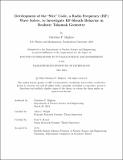Development of the “Stix” Code, a Radio Frequency (RF) Wave Solver, to Investigate RF-Sheath Behavior in Realistic Tokamak Geometry
Author(s)
Migliore, Christina P.
DownloadThesis PDF (31.18Mb)
Advisor
Wright, John C.
Bonoli, Paul T.
Terms of use
Metadata
Show full item recordAbstract
A favorable method to heat plasmas to fusion relevant temperatures is to use radio frequency (RF) waves in the ion cyclotron range of frequencies (ICRF). However, experiments have shown that this technique produces RF rectified sheaths known to form on both the ICRF antenna as near-field sheaths and farther away from the antenna in the torus as far- field sheaths. These RF sheaths can result in large DC voltages on plasma facing components (PCFs) causing adverse effects such as impurity generation from sputtering of high-Z metallic coatings, edge power dissipation, and hot-spot formation. With many current and upcoming tokamaks relying on ICRF for heating, it is becoming increasingly critical to numerically model RF sheaths for advancing mitigation methods. Due to the size of the RF sheath in comparison to the launched RF wavelength, the RF sheath can be reduced to a boundary condition (BC) on the computational domain boundaries. Traditionally, many electromagnetic (EM) RF solvers use conducting wall BCs that do not include the effects of sheaths while other codes use overly simplified models that do not capture accurate rectification. Recently, J. Myra et. al 2015 models the RF sheath as a non-linear BC using a characteristic sheath impedance allowing for a more representative calculation of DC enhanced potentials on PFCs.
In this thesis, the novel finite-element plasma RF wave solver called “Stix” that includes the full non-linear RF sheath BC is introduced with the goal of investigating RF sheath behavior in realistic tokamak geometry. First, it is demonstrated that Stix can replicate previous analytical and numerical RF sheath cases as verification of the solve. Next, focusing on near-field sheaths, the experimental antenna power phasing study done on Alcator C-Mod is chosen to be simulated with Stix. Using a magnetic field aligned two-dimensional (2D) slice along the 4 straps of the C-Mod ICRF antenna, it is seen that Stix can reproduce the experimental minimization trend in the enhanced potentials found when varying the strength of the power ratio between the 2 inner straps versus the total 4 straps. Similarly, Stix confirms that the monopole phasing of the 4 straps produces significantly higher potentials as found in experiment. For the various antenna phasing schemes, an estimate of erosion rate from the DC voltages shows that even in the lowest voltages cases the sputtering is notable. To examine the behavior of far-field sheaths, a predictive study is chosen for the upcoming SPARC tokamak. Using a 2D simulation in the poloidal cross-section of SPARC, the effect of varying the strength of wave-particle absorption on the enhanced potentials is investigated. It is found that even with the lowest absorption scenario, the calculated voltages along the vacuum vessel are negligible. This result is discovered to be due to the small magnetic field angles, bn, into the walls as direct consequence of the poloidal cross-section reference frame. Further investigation through the addition of limiter-like bumps shows that far-field rectification is dominated by the strength of bn. The findings from both the comparison and predictive modeling of RF sheaths done in Stix show the effectiveness such a numerical tool has for furthering the optimization of ICRF heating.
Date issued
2024-05Department
Massachusetts Institute of Technology. Department of Nuclear Science and EngineeringPublisher
Massachusetts Institute of Technology